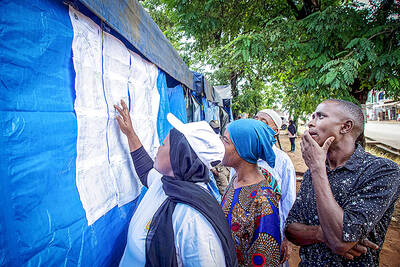"I am afraid," one prisoner awaiting interrogation and almost certain death at the hands of the Gestapo scrawled on the walls of his Paris prison cell.
"Never confess," reads another defiant message etched into the plaster nearby.
Heart-rending words transformed by history into epitaphs, these and other messages on long-forgotten walls in the Gestapo's World War II Paris headquarters went on exhibit for the first time ever over the weekend, part of France's annual heritage day.
More than 15,000 sites normally closed to the public, ranging from the national archives to the finance ministry, opened their doors to some 10 million visitors on Saturday and yesterday.
Most of the rooms at 11, rue de Saussaies in the 8th arrondissement were renovated after the French interior ministry took possession of this notorious address where hundreds, if not thousands, of resistance fighters and other hapless victims of the Nazi occupation were tortured and condemned to die.
It was as if France's post-war leaders were eager to turn a page.
But a few prison cells were left untouched, and the plaintiff expressions of fear and foreboding, patriotism and pride, preserved on their walls stand today as a moving testament of Gestapo cruelty and human defiance.
"Frankreich ueber alles" -- "France above all" -- reads on inscription with biting irony, a play on words transforming the title of the German national anthem.
"Believing in yourself gives one the power to resist despite the bathtub and all the rest," reads another, a dark allusion to a preferred technique of torture practiced by the Gestapo.
"Don't talk," commands another, as if to give courage.
Most of the unfortunates interrogated and tortured here were later executed or deported to camps, historians say.
The few rooms that remain from that era have been left intact: the ceiling lamp that still casts a wan, sinister light over the room; the thick metal ring attached to the wall, to which prisoners were chained; the barred window with a view of the interrogation chambers on the other side of the courtyard.
The prisoner graffiti -- written with bits of lead or pencils hidden in shirt collars, or simply carved with any sharp object at hand -- is today protected by glass barriers.
Many of those detained here had no illusions as to their destiny. "Julien. 20 years old. Headed for the post," reads one, referring to the wooden poles to which prisoners were attached before being executed by firing squad.
"Labiscotte. Arrived June 8, 1944. For liberty of for death?" reads another, still daring to hope.
And yet another: "Honored to be condemned by the Bosh. Goodbye forever to France and my loved one," it says, using a common name for Germans during the war.
Some inscriptions are like diary entries: "Marcel is thinking of Simone and Kiki"; "Guillaume loves Marianne"; "I cannot sleep for thinking about my parents and my beloved Louisette."
Other parts of the walls are like bulletin boards, with messages the authors hoped would, somehow, find their way to intended recipients. "Roger: your father, your cousin and Colette's father came through here 24-5-44."
There are even expressions of optimism -- "We will be free by Christmas 1944" -- and philosophical resignation: "Life is beautiful."
United in their misery, one finds the hammer-and-sickle emblem of communism next to Christian prayers. "My God I want, All that you want, Because you want it, As you want it, As much as you want it," reads one.
The walls were also common ground for the barely literate and the highly cultivated, such as Yvette Marie-Jo Wilbort who -- not daring to imagine that she would live to see the war's end -- quoted from memory, for her epitaph, a verse from a poem by Alfred de Vigny.
"Wailing, pleading, crying -- these are the coward's call. Assume your heavy and onerous burden, the one that fate has cast your way. And then, like me, suffer and die in silence."
Wilbort survived, one of the few.

With much pomp and circumstance, Cairo is today to inaugurate the long-awaited Grand Egyptian Museum (GEM), widely presented as the crowning jewel on authorities’ efforts to overhaul the country’s vital tourism industry. With a panoramic view of the Giza pyramids plateau, the museum houses thousands of artifacts spanning more than 5,000 years of Egyptian antiquity at a whopping cost of more than US$1 billion. More than two decades in the making, the ultra-modern museum anticipates 5 million visitors annually, with never-before-seen relics on display. In the run-up to the grand opening, Egyptian media and official statements have hailed the “historic moment,” describing the

‘CHILD PORNOGRAPHY’: The doll on Shein’s Web site measure about 80cm in height, and it was holding a teddy bear in a photo published by a daily newspaper France’s anti-fraud unit on Saturday said it had reported Asian e-commerce giant Shein (希音) for selling what it described as “sex dolls with a childlike appearance.” The French Directorate General for Competition, Consumer Affairs and Fraud Control (DGCCRF) said in a statement that the “description and categorization” of the items on Shein’s Web site “make it difficult to doubt the child pornography nature of the content.” Shortly after the statement, Shein announced that the dolls in question had been withdrawn from its platform and that it had launched an internal inquiry. On its Web site, Le Parisien daily published a

‘NO WORKABLE SOLUTION’: An official said Pakistan engaged in the spirit of peace, but Kabul continued its ‘unabated support to terrorists opposed to Pakistan’ Pakistan yesterday said that negotiations for a lasting truce with Afghanistan had “failed to bring about a workable solution,” warning that it would take steps to protect its people. Pakistan and Afghanistan have been holding negotiations in Istanbul, Turkey, aimed at securing peace after the South Asian neighbors’ deadliest border clashes in years. The violence, which killed more than 70 people and wounded hundreds, erupted following explosions in Kabul on Oct. 9 that the Taliban authorities blamed on Pakistan. “Regrettably, the Afghan side gave no assurances, kept deviating from the core issue and resorted to blame game, deflection and ruses,” Pakistani Minister of

UNCERTAIN TOLLS: Images on social media showed small protests that escalated, with reports of police shooting live rounds as polling stations were targeted Tanzania yesterday was on lockdown with a communications blackout, a day after elections turned into violent chaos with unconfirmed reports of many dead. Tanzanian President Samia Suluhu Hassan had sought to solidify her position and silence criticism within her party in the virtually uncontested polls, with the main challengers either jailed or disqualified. In the run-up, rights groups condemned a “wave of terror” in the east African nation, which has seen a string of high-profile abductions that ramped up in the final days. A heavy security presence on Wednesday failed to deter hundreds protesting in economic hub Dar es Salaam and elsewhere, some